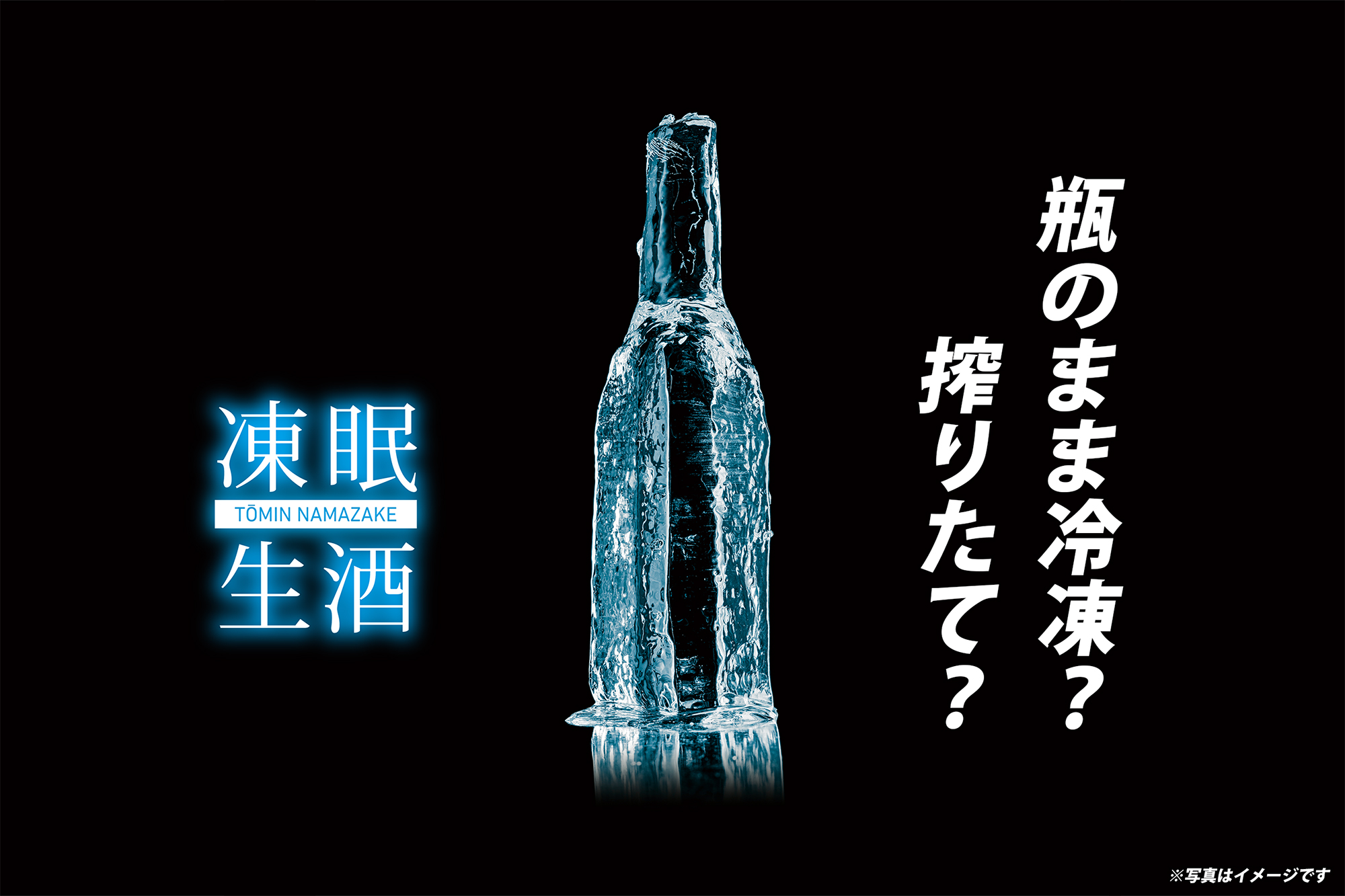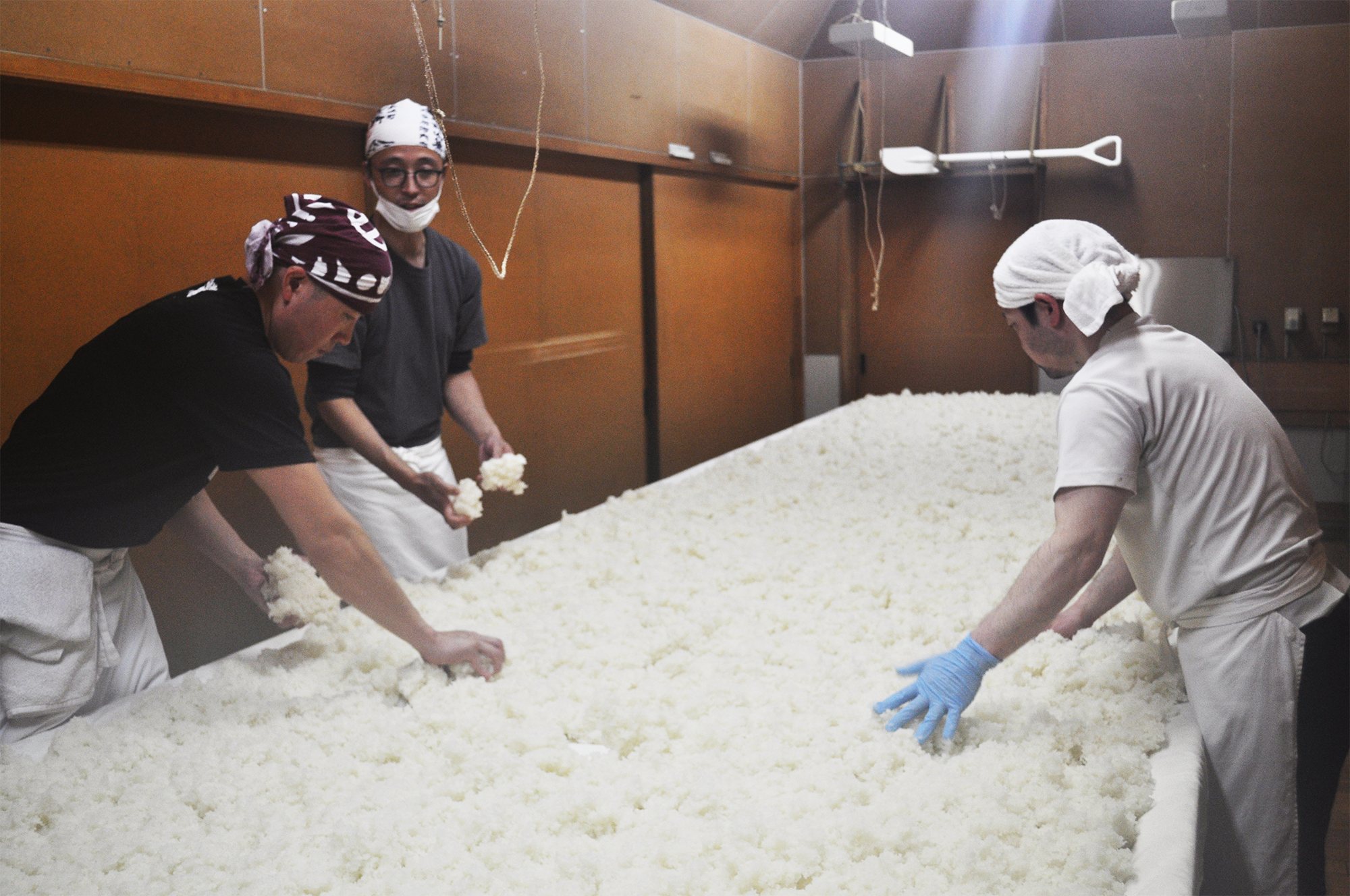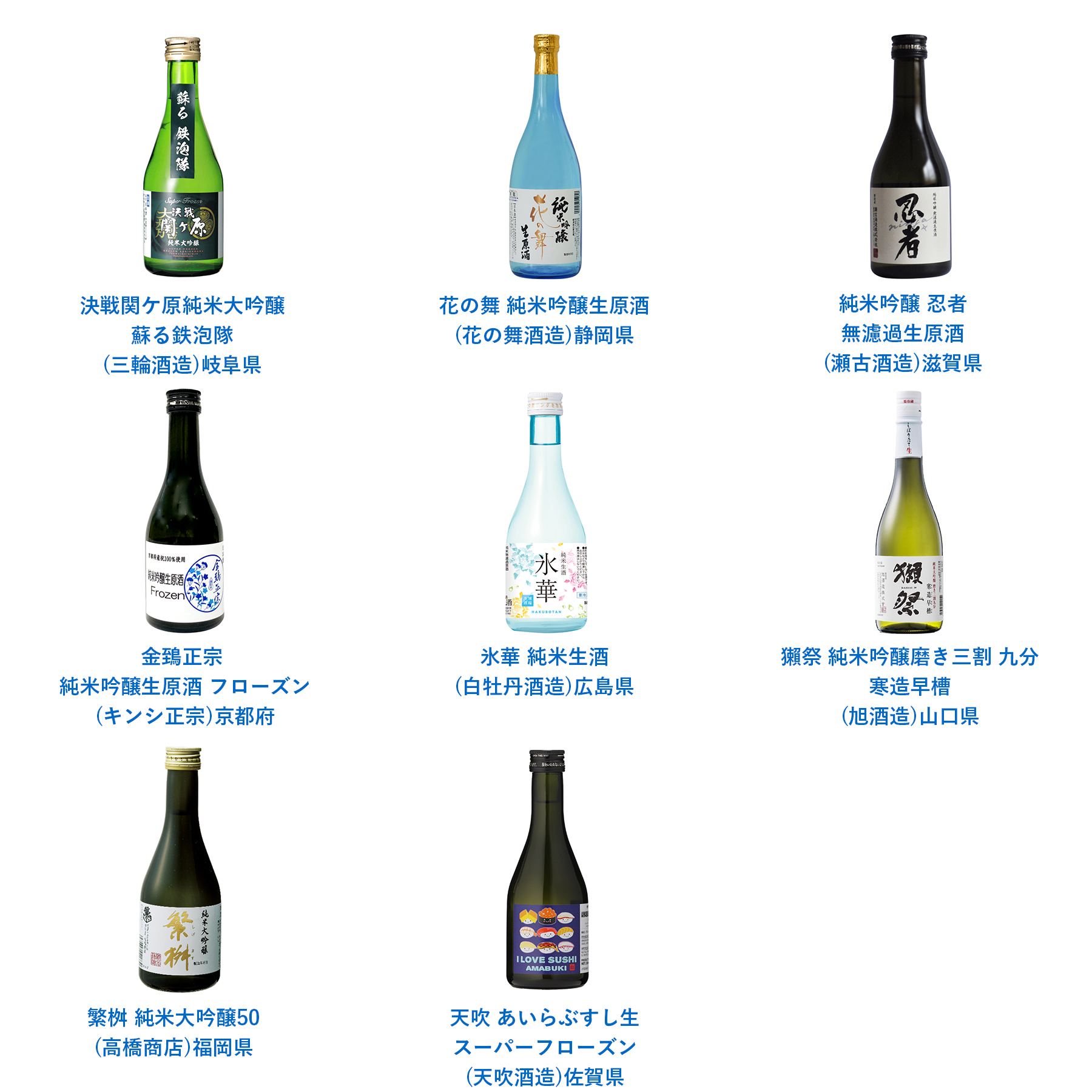An industry first! Twenty-six sake breweries from all over Japan have gathered together! We will start selling “Frozen Sake”, freshly pressed “Nama-Sake” frozen with our unique technology, at “TOMIN FROZEN” from May 19 (Fri.)!

(Headquarters: Yokohama City, Kanagawa Prefecture; President: Yoshio Yamada) has collaborated with 26 sake breweries across Japan, including Asahi Shuzo, popular for Dassai, and Nanbu Bijin, to sell freshly pressed, unpasteurized sake frozen in a frozen state. This sake can be enjoyed half-frozen, making it perfect for the upcoming hot season. The sake will be available for pre-sale on the EC mall of TOMIN FROZEN (Yokohama), a frozen food specialty store, from Friday, May 19, and in stores from Saturday, May 20, and the general public can also casually enjoy the sake through tasting events. For a limited time, a campaign will be held, offering a 10% discount for purchases of 4,000 yen or more including sake at stores and a 1,000 yen discount for purchases of 10,000 yen or more including sake at the EC site.
Introducing the appeal of frozen raw sake.
-
Point
Even fresh sake, which tends to lose its freshness, can enjoy the pure flavor of freshly pressed sake through freezing and frost sleep!
Contents
What is fresh sake? Why is it frozen?

Sake is an alcoholic beverage fermented using the power of “koji mold. Since rice and water are the main ingredients, freshly pressed nama-shu is characterized by its sweet, clear, and cool taste.
Because fermentation proceeds very quickly with the power of koji mold, the flavor of nama-sake can easily change. Therefore, in order to prevent the koji fungus from causing more fermentation than necessary, sake is usually heated through a process called “hi-ire” when it is distributed. This process helps stabilize the flavor of the sake.
After pressing, it is difficult to keep the sake fresh because the koji fermentation is in progress. However, sake lovers who really want to enjoy the pure taste of nama-sake will visit the brewery to taste it.
As mentioned above, the taste of nama-sake changes over time due to the fermentation of the koji. Freezing is the best way to seal in the flavor. But why hasn’t sake been frozen until now?
To be precise, we can say that it is “impossible” to freeze and store sake in frozen state. Normally, freezing causes the sake to expand and the bottle to crack. Sake is usually around 15% alcohol. On the flip side, about 85% is water. Water expands when frozen, but the slower it freezes, the greater the rate of expansion.
Conventional freezing takes too long, and the expansion causes the bottles to crack.
In addition, the taste of the product deteriorates. Water freezes at 0°C, but alcohol does not. Therefore, if frozen slowly, only the water will gradually freeze first, and the water and alcohol will separate. When this happens, the taste and the quality deteriorates, which was another reason why frozen storage of sake was not widely used.
However, since sake can be frozen very quickly with TOMIN, the expansion rate is very low and the bottle will not break. In addition, because there is very little separation between the water and alcohol content, the flavor of the sake can be enjoyed after thawing as it was before freezing.
This technology has made it possible to preserve the taste of freshly squeezed sake in the same state as it was in the warehouse, even though it has been difficult to keep it fresh.
How to enjoy "common" frozen sake
Yuki Aoi, a traveling freelance announcer and sake connoisseur, tasted three kinds of sake. She tasted “Shin Nokaya,” “Nanbu Bijin,” and “Izumibashi Junmai Ginjyo Nama sake (raw). What are the characteristics of each?
1. Shin-Nokaya
Commented that this sake is very smooth on the palate, has a mellow aroma, and is smooth, crisp, and well-balanced. As a pairing, we recommend scallops and other sweet shellfish, sakura shrimp, and raw shirasu!
2. Nanbu bijin
This sake is also smooth on the palate and has a deep taste. It is a type of sake with a long aftertaste. We recommend pairing with fresh cheese and bonito!
3.Izumihashi Junmai Ginjyo Nama Sake
This sake has a refreshing acidity and a long lingering taste. Because of its acidity and umami, this nama sake goes well with well-seasoned dishes such as meat dishes.
In the video, you can see how to enjoy it with Japanese food in a “sake connoisseur’s” way.
Verification: Serve the frozen sake to the general public.
We served the sake to a customer who came to Sushi Shinshiro in Ebisu, Tokyo! What was their reaction?
Will the Sake Industry Boosted by TOMIN?
Sake can be enjoyed in various ways as it is heated and time passes, such as “hi-ire-sake” and “ko-shu,” but the origin of sake can be traced back to “nama-sake,” or “unpasteurized sake. Many sake lovers are captivated by the fresh, sweet flavor of nama-sake. From early fall to early spring, sake breweries begin pressing sake. Because you have to visit the brewery during the pressing period to drink nama-sake, there have been restrictions on both time and distance.
However, by freezing the sake in the freezer, it is now possible to enjoy it anytime, anywhere, even overseas, with the same flavor as when drinking it at the sake brewery.
Eventually, it may be possible to enjoy freshly pressed, unpasteurized sake overseas with its flavor intact. When exporting sake overseas, it has been particularly difficult to transport fresh sake to the destination, but by freezing it in a frozen state, the flavor can be preserved. In addition, while it is difficult for breweries to export sake on their own, if they could export a single batch of frozen sake, they would be able to export even small lots of sake, contributing to a further breakthrough in the sake industry. We interviewed Kosuke Kuji, president of Nanbu Bijin, the creator of the Frozen Sake.
Learning about Sake Brewing~Izumihashi Sake Brewery
We took a tour of a sake brewery in Ebina City, Kanagawa Prefecture, which has been making sake since the Edo period. Mr. Tanaka of the Izumihashi Sake Brewery guided us around the brewery. Work began at 6:30 in the morning.
Sake is made from fermented rice. For this reason, we were first shown the process of burning steamed rice and then cooling it down, known as “roji-hourei.
1. steamed rice, cooling in the alley
The steamed rice is broken into small pieces so that the moisture can be removed from the steamed rice. This is called “cooling in the alley. The amount of water content varies depending on the type of “koji” to be made, so the process is carefully carried out while checking the condition of the rice. 2.
2. making koji
Once the temperature of the steamed rice has cooled to around 30℃, the next step is to make koji. Spores called “koji mold” are sprinkled on the koji rice. This process takes three days.
3. making Shubo
The next process is called “shubo”, which is used to grow yeast. By warming and cooling, the yeast is given the proper amount of stress and nutrients to grow.
4. Making unrefined sake
In the moromi process, rice, koji, brewing water, and the aforementioned shubo are added and fermented in a tank. 3 stages are carefully prepared over 4 days.
5. Pressing
The unrefined sake is placed in a sake bag and pressed. The freshly pressed sake is called “nama-sake. Freshly pressed sake is characterized by its fresh, crisp taste. This fresh, unpasteurized sake can only be enjoyed in the brewery, but the greatest appeal of this freshly pressed sake is that by freezing the freshly pressed sake, you can enjoy the same flavor as you would in the brewery.
Product List



How to purchase, event information

Available at TOMIN FROZEN (Yokohama store) or online store.
https://tominfoods.base.shop/categories/4015629
About the Reception (Event)
At the reception on Thursday, May 18, you will be able to enjoy a tasting of frozen sake from participating breweries and a marriage of frozen foods from TŌMIN FROZEN. Yuki Aoi will be the MC for the talk session, and Nanbu Bijin President Kuji will be the guest speaker to talk about the appeal and possibilities of frozen sake.
*This reception party is for sake brewers and members of the press.
The event will also include a tasting event of the frozen sake, which will be available for pre-sale on EC from May 19 (Fri.) and in stores from May 20 (Sat.). The event will be held at TŌMIN FROZEN in Yokohama (Nakamachidai), where you can enjoy 24 different brands of sake from 24 breweries, changing weekly for 6 weeks until 6/30 (Fri.). Please stop by.
About TŌMIN FROZEN
【Store Information】
Address: K Building 1F, 1-32-5 Nakamachidai, Tsuzuki-ku, Yokohama City, Kanagawa Prefecture
About Technican
【Company Profile】
Name: Technican Co., ltd.
Representative: Yoshio Yamada, President
Location: 3-1-16 Chigasaki Minami, Tsuzuki-ku, Yokohama 224-0037
Contact: Technican Public Relations (TEL : 045-948-4855)
WEB site: https://www.technican.co.jp/
<About Technican’s freezing technology and frozen sleep>
Conventional freezing technology uses cold air to freeze food, but Technican’s freezing technology uses cold liquid (alcohol) to freeze food. Technican’s freezing technology freezes food with cold liquid (alcohol), which freezes even faster than conventional quick freezing, so the taste and flavor of the food does not deteriorate after thawing. This technology is also attracting attention from the perspective of regional development, as it allows food to be transported from the place of production to the place of consumption with the freshness it had before being frozen.
Click here to learn more about the technology of frozen sleep >>


